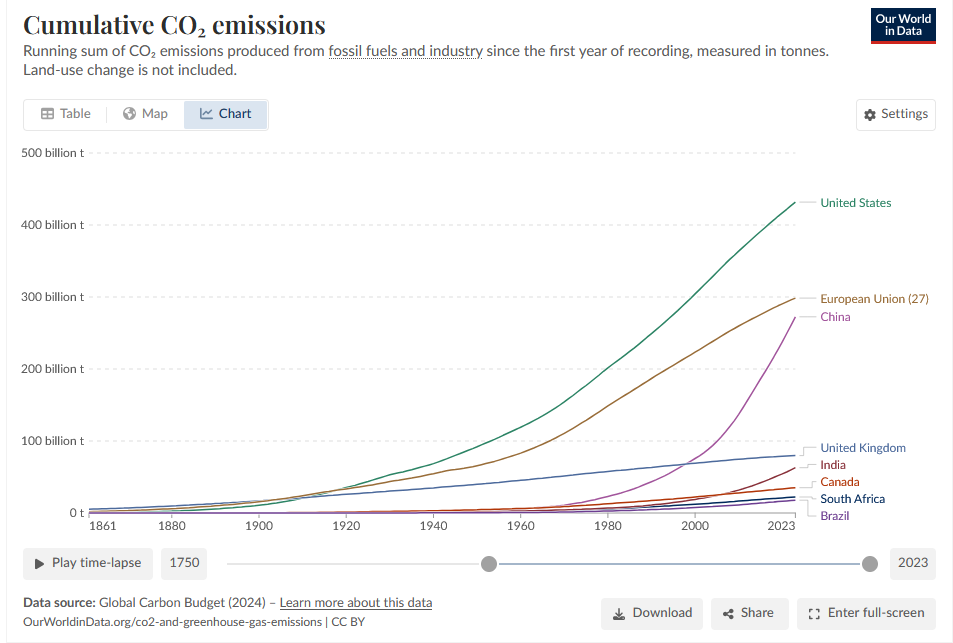Last year China generated almost 3 times as much solar power as the EU did, and it's close to overtaking all OECD countries put together (whose combined population is 1.38 billion people)
-
The question is simple. If you have installed solar power of 40% your country peak use, how much nuclear power you need - assuming simplified you have only these two power sources.
Not really enough information. I will assume that by "installed solar power" you mean peak generation when the sun is shining, and that instead of peak use, you mean 40% of average use, i.e. let's suppose that at an average moment the country consumes 100GW and, if the sun is shining, generates 40GW from solar.
Assume further the sun is up for half the year and the sky is clear for half the year, meaning the total amount of your yearly electricity you can generate with solar is 10% assuming typical weather. Then you would be able to reliably power the country with a combination of nuclear totalling 90% of average use (90GW) and enough storage that you can ride out cloudy periods.
-
Not so sure about that. China overtook the EU in 1987 in coal consumption, but today it is at 25,000TWh or so. In 1965 the current EU countries were at 4,500TWh. It certainly is not much less, if China has not overtaken the EU by cumulative coal consumption.


Coal consumption
Coal consumption by country or region, measured in terawatt-hours (TWh).

Our World in Data (ourworldindata.org)
If you "aren't sure" about that, then why the hell are you trying to discuss it making guesses instead of informing yourself?

China, a country with 4-5 times the US population, has half the cumulative historic emissions. And yet you have the fucking nerve to blame china for coal. The US and the EU get to pollute the fucking Earth for 2 centuries, and China does a renewable revolution in its 40 years since industrializing and you cry about how they still have plans for coal.
Just, seriously, stop arguing from ignorance. If you do not know about cumulative emissions, don't make "Oh I'm not so sure about that because look at the trends for the past 60 years", as if the US and EU hadn't been emitting fossil CO2 since the fucking late 18th century.
-
Good on them. The earlier they can shut down those coal plants, the better.
They are going to keep those coal plants as back up but the amount they use then is decreasing.
At the same time they are rapidly moving transport into electricity and they are growing their electrical demand.
This year should be the tipping point where coal and oil usage drops. Capacity and number of coal is meaningless.
-
to be fair, they have about 3x the population too. but nonetheless good to see that they are moving fast. dictatorship works faster when it comes to regulation ¯_(ツ)_/¯

The dictatorship is fast is a lure, it's actually not useful, as they run in the direction of the dictator but usually doesn't adjust or stop in time. Sometimes you see something good coming out if it, but you shouldn't forget all the bad things they do too.
That said, I hope we'll have enough solar for everyone in a decade or so!
-
Not really enough information. I will assume that by "installed solar power" you mean peak generation when the sun is shining, and that instead of peak use, you mean 40% of average use, i.e. let's suppose that at an average moment the country consumes 100GW and, if the sun is shining, generates 40GW from solar.
Assume further the sun is up for half the year and the sky is clear for half the year, meaning the total amount of your yearly electricity you can generate with solar is 10% assuming typical weather. Then you would be able to reliably power the country with a combination of nuclear totalling 90% of average use (90GW) and enough storage that you can ride out cloudy periods.
Yes, something like that. Now, while you can theoretically install that many solar panels, the kicker is that you don't have nowhere enough storage. And even if you had that 10%, you could increase solar all you want, but the nuclear would be still running at 90MW because of the storage, or better, the lack of it. And because you would have a surplus of cheap solar power energy during the day - assuming more solar panels than 10%, it would erode more expensive nuclear one to become even more expensive.
Basically if we solve storage, we can get rid of nuclear, but not before. -
3 times as much solar as the EU.
Has 3 times the population.

They are using 50% of the world's coal though, so maybe let's not start tugging each other off just yet.
You sound like all the right-wing politicians the world over who don't want to implement zero carbon solutions because "China still burn coal".
We're on a sinking ship and you're complaining that you don't like the colour of the life raft.
If China was the only country in the world that burned coal, but they exclusively burned coal, and everybody else was on solar panels the world would still be an infinitely better place and it is right now. Not doing something just because other people also aren't doing it just ensures that nobody does anything.
-
the coal industry growth is slowing down
Wow I hope that really really recently changed. Last I checked China was one of the world's worst polluters, and they reached a 10 year high last year.

China’s construction of new coal-power plants ‘reached 10-year high’ in 2024 - Carbon Brief
A “resurgence” in construction of new coal-fired power plants in China is “undermining the country’s...
Carbon Brief (www.carbonbrief.org)
Please explain how being the #1 coal guy is a "positive dynamic".
Huh, I was under the impression the total coal capacity is still growing, not the speed at which new coal plants are built. Thanks for that piece!
-
This has been going on for years and will continue.
China really really really needs a robust and diverse energy infrastructure.
Industry needs huge amounts of energy. AI needs huge amounts of energy. The military needs huge amounts of energy.Coal is unreliable and dirty. Oil can be blocked at the Straight of Malacca and a few pipelines.
China is also the world’s factory. They own the entire logistics chain for producing renewable generators; from raw materials to final assembly. They have all the infrastructure to not only build solar panels and wind turbines at scale, they’ve scaled up building the machines that build them.
Coal is unreliable
How? I would've said coal is very reliable, it worked for over a hundred years.
-
If you "aren't sure" about that, then why the hell are you trying to discuss it making guesses instead of informing yourself?

China, a country with 4-5 times the US population, has half the cumulative historic emissions. And yet you have the fucking nerve to blame china for coal. The US and the EU get to pollute the fucking Earth for 2 centuries, and China does a renewable revolution in its 40 years since industrializing and you cry about how they still have plans for coal.
Just, seriously, stop arguing from ignorance. If you do not know about cumulative emissions, don't make "Oh I'm not so sure about that because look at the trends for the past 60 years", as if the US and EU hadn't been emitting fossil CO2 since the fucking late 18th century.
Maybe that is because I have the elementary school education necessary to understand that burning coal and gas also causes emissions. So when I am looking at cummulative coal consumption, I have the very basic common sense to not look at CO2.
EDIT: Btw 2/3 of EU emissions happened in the last 60 years. So this very likely shows most of the EU coal consumption. Also if you happen to have actual coal numbers and want to share them, I am happy to have a look at them. But please no CO2 = coal bs.
-
Ain't that neat! Do they just happen to be the biggest coalie bois too?
This is also such BS the west has outsourced our pollution to China. They manufacture almost everything and we go look at them.
-
You sound like all the right-wing politicians the world over who don't want to implement zero carbon solutions because "China still burn coal".
We're on a sinking ship and you're complaining that you don't like the colour of the life raft.
If China was the only country in the world that burned coal, but they exclusively burned coal, and everybody else was on solar panels the world would still be an infinitely better place and it is right now. Not doing something just because other people also aren't doing it just ensures that nobody does anything.
I think that you misunderstood his comment. He's not criticizing solar energy, he's calling out China's green washing as they have the same solar production per Capita than Europe but they have way more coal production per Capita than Europe.
A right wing politician would throw a fit about how solar energy is dangerous and make kids trans.
-
It's a better measure because western countries outsource manufacturing and associated pollutions to other countries and then pretend to be green.
And China is continuing to increase market share on goods like electronics and vehicles, by choice.
The USA has the highest GDP in the world and has a CO2 per GDP of 0.26 to Chinas 0.44. Are you saying China is just pretending to be green and the USA is a beacon of hope for the environment? Rhetorical Question, Farley.
-
And China is continuing to increase market share on goods like electronics and vehicles, by choice.
The USA has the highest GDP in the world and has a CO2 per GDP of 0.26 to Chinas 0.44. Are you saying China is just pretending to be green and the USA is a beacon of hope for the environment? Rhetorical Question, Farley.
You're comparing GDPs in dollars, not PPP. Your calculation is invalid because of that. Since cost of life in China is several times lower than in the USA, pure GDP metrics in dollars are a bad comparison unless you convert them to purchase power parity (PPP), which gives a much more comparable metric in terms of amounts of goods/services manufactured and traded than straight GDP. Run the calculation again using PPP adjusted GDP and tell me your findings.
-
You're comparing GDPs in dollars, not PPP. Your calculation is invalid because of that. Since cost of life in China is several times lower than in the USA, pure GDP metrics in dollars are a bad comparison unless you convert them to purchase power parity (PPP), which gives a much more comparable metric in terms of amounts of goods/services manufactured and traded than straight GDP. Run the calculation again using PPP adjusted GDP and tell me your findings.
I am not comparing them with USD, the user who brought up GDP did because their source specifies it.
-
I think that you misunderstood his comment. He's not criticizing solar energy, he's calling out China's green washing as they have the same solar production per Capita than Europe but they have way more coal production per Capita than Europe.
A right wing politician would throw a fit about how solar energy is dangerous and make kids trans.
But in Europe they also burn coal, no? Or burning gasoline, natural gas, trash, anything.
-
Maybe that is because I have the elementary school education necessary to understand that burning coal and gas also causes emissions. So when I am looking at cummulative coal consumption, I have the very basic common sense to not look at CO2.
EDIT: Btw 2/3 of EU emissions happened in the last 60 years. So this very likely shows most of the EU coal consumption. Also if you happen to have actual coal numbers and want to share them, I am happy to have a look at them. But please no CO2 = coal bs.
What's the point of comparing coal if not for CO2? Most other forms of pollution from coal are local, not global, the international debate here is on climate change, a western-world inhabitant has no right to say what China should be doing with the local pollution. The discussion on coal is started because of its horrendous climate change potential, which comes exclusively from its cumulative CO2 emissions.
But if you want to compare coal numbers, I ran the calculations using this source for US production and this source for China production. Downloading the CSVs from both sources, I get that the US has produced 85643270043 short tons of coal, which at 21GJ of energy per short ton amount to 496731 TWh, whereas China has extracted 617787 TWh, i.e. a bit below 25% more than the USA. Since China has 1411 mn inhabitants and the US has 340 mn inhabitants, i.e. China has 415% the population of the USA, China has along its existence as a country extracted about 1/3 as much coal per inhabitant than the USA.
So yeah, China would have to literally consume twice as much coal as it's already consumed to reach US values of per-capita historical cumulative coal consumption.
Now what will you come up with? Suddenly coal numbers don't matter anymore?
-
If you trade too much EV energy during night, then you can't drive during the day. And again, EVs capacity is not reliable at all. As per green H2, please show me a production and a storage capable of providing energy to a city. Or at least a real project that's building it. Storing H2 is a big problem, like a huge one. If nothing else, Hindenburg tells a story. The fact that energy loss is at more than 50% when producing green H2 is a minor problem compared to storage.
You need H2 only after solar + EVs provides more than 24 hours of needed energy in an area. Although H2 does save on transmission costs for medium to long distance. One of the remarkable aspects of BYD Dolphin, now under $9000 for 32kwh battery is that the battery value alone is $260/kwh capacity, and if you never drove it, but sold electricity 2.6c/kwh higher at night than you pay at day, then you pay for the car in its entirety. Just batteries can be sold under $100/kwh in China, and you could make 200% ROI from 3c/kwh price differential. EVs and batteries can be paid by private sector instead of utility investment markup model.
H2 technologies are advancing, including storage and pipes. Electrical transmission is more than 10x more expensive than transmitting gas/H2, and saves money on that end relative to efficiency loss. Surplus solar with input cost at 2c/kwh or less achieves under $2/kg H2 target which is equivalent driving distance to $1/gallon gasoline, and 10c/kwh electric only value delivered energy, and 6c/kwh combined heat and electricity value.
-
I am not comparing them with USD, the user who brought up GDP did because their source specifies it.
You're right, you're referring to the original source, which is supposedly already in PPP dollars, so I deleted my previous comment. Thanks for the correction. Regardless, that data is 2011, so it's kinda useless to me because that's before the energy transition of China.
-
You need H2 only after solar + EVs provides more than 24 hours of needed energy in an area. Although H2 does save on transmission costs for medium to long distance. One of the remarkable aspects of BYD Dolphin, now under $9000 for 32kwh battery is that the battery value alone is $260/kwh capacity, and if you never drove it, but sold electricity 2.6c/kwh higher at night than you pay at day, then you pay for the car in its entirety. Just batteries can be sold under $100/kwh in China, and you could make 200% ROI from 3c/kwh price differential. EVs and batteries can be paid by private sector instead of utility investment markup model.
H2 technologies are advancing, including storage and pipes. Electrical transmission is more than 10x more expensive than transmitting gas/H2, and saves money on that end relative to efficiency loss. Surplus solar with input cost at 2c/kwh or less achieves under $2/kg H2 target which is equivalent driving distance to $1/gallon gasoline, and 10c/kwh electric only value delivered energy, and 6c/kwh combined heat and electricity value.
EVs provides more than 24 hours of needed energy in an area
Only if it was fully charged, you don't drive with it and you live in a house. And thus are not a reliable energy source at all, even less for general energy problems.
H2 technologies are advancing, including storage and pipes.
All technology isAll technologies are advancing, but do you have a solution today? And even with advancements, you'll hardly solve H2 flammability. Even keeping it contained is problematic. -
I think that you misunderstood his comment. He's not criticizing solar energy, he's calling out China's green washing as they have the same solar production per Capita than Europe but they have way more coal production per Capita than Europe.
A right wing politician would throw a fit about how solar energy is dangerous and make kids trans.
They burn more coal than Europe because there's more energy demand in Europe and solar alone can't fulfil it. Which is also the same in Europe.







